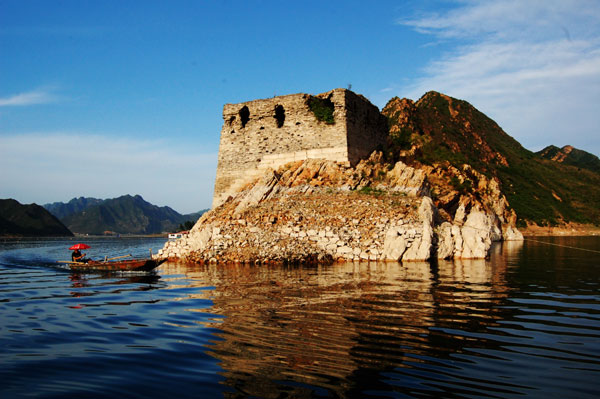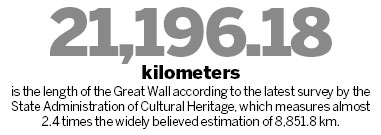Great Wall much longer than previously believed
Updated: 2012-06-13 07:31
By Cheng Yingqi (China Daily)
|
||||||||
Archaeologists, mapping experts find 43,721 sites related to the structure
In 2008, a construction team building a new expressway linking Shenmu county and Yulin city, both in Shaanxi province, found the remains of an ancient wall buried in the ground. The ruins were only 30 centimeters high.
Archaeologists later learned that the wall belonged to a section of the Great Wall of China, and they discovered more ruins.
To protect the new discovery, the local government decided to dig a tunnel under the walls for the new expressway to pass.
Now China's cultural protection authority will end the trouble to change the construction plan at the last minute since some of the Great Wall has been found - the authority has figured out the length and location of all of the walls.
Last week, the State Administration of Cultural Heritage published its latest survey result, which said the Great Wall measures 21,196.18 kilometers, almost 2.4 times the widely believed estimation of 8,851.8 km.
"The previous estimation particularly refers to Great Walls built in the Ming Dynasty (1368-1644), but this new measure includes Great Walls built in all dynasties," said Yan Jianmin, office director of the China Great Wall Society, an NGO founded by specialists and scholars to protect the Great Wall of China.
|
 |
| A section of the Great Wall at the Panjiakou Reservoir in Hebei province in May. Locals found the section of the "underwater Great Wall" surfaced after the water level of the reservoir fell by more than 10 meters because of a lingering drought. [Photo/Xinhua] |
Qin Shi Huang, the first emperor of the Qin Dynasty (221-206BC), was famous for building the Great Wall, the world's largest human-made structure. But construction of the wall had begun as early as 7th century BC.
The oldest section of the Great Walls that has been found is the Great Wall of Qi State in Shandong province, and the Great Wall of Chu State in Henan province. Both date back to the Spring and Autumn Period (770-476BC), according to Yan.
"As thousands years pass, some ground structures disappear, and we do not know where the walls used to be. When some local governments or companies develop the land, like coalmining or building new roads, they destroy the remaining parts under the ground," Yan said.
|
 |
"Now we are clear about the location of the Great Wall, so the government can take steps to protect the walls, and local governments are clear about their responsibility to protect the walls," he said.
The survey was performed jointly by the State Administration of Cultural Heritage and the National Administration of Surveying, Mapping and Geoinformation.
Archaeologists and mapping experts conducted field surveys in 15 provinces, municipalities and autonomous regions including Heilongjiang, Hebei, Beijing, Shaanxi and Xinjiang, and found 43,721 sites related to the Great Wall.
"In Shaanxi province, we knew of only 20 percent of the early walls (before the Ming Dynasty) before the survey," said Li Gong, a researcher in charge of the Great Wall survey at the Shaanxi Provincial Institute of Archaeology.
Using historical records, artifacts and information from locals, Li and his colleagues unveiled small parts of the Great Wall that had long been forgotten by people.
"Some of the early Great Wall has a tiled roof, so when the walls collapse there would be shattered tiles," Li said. "Even with the clue, we still spent a whole month before we spotted the first defensive structure."
The Great Wall was a defensive structure built by ancient Chinese empires for protection from marauding tribes.
Some walls are built on a ridge; others use steep mountain cliffs as a natural fence, and link the cliffs and walls with watchtowers.
"In the past we did not count the defense cliff into the whole length of the Great Wall, but they surely are part of the defensive structure. Now we count it, so this would make the total length longer too," Li said.
The survey is only the first step in a larger project to protect the Great Wall. The State Administration of Cultural Heritage launched a protection project in 2006, and planned on a long-term maintenance map to be completed before the end of the 12th Five-Year Plan (2011-15) period.
Contact the writer at chengyingqi@chinadaily.com.cn

 Relief reaches isolated village
Relief reaches isolated village
 Rainfall poses new threats to quake-hit region
Rainfall poses new threats to quake-hit region
 Funerals begin for Boston bombing victims
Funerals begin for Boston bombing victims
 Quake takeaway from China's Air Force
Quake takeaway from China's Air Force
 Obama celebrates young inventors at science fair
Obama celebrates young inventors at science fair
 Earth Day marked around the world
Earth Day marked around the world
 Volunteer team helping students find sense of normalcy
Volunteer team helping students find sense of normalcy
 Ethnic groups quick to join rescue efforts
Ethnic groups quick to join rescue efforts
Most Viewed
Editor's Picks

|

|

|

|

|

|
Today's Top News
Health new priority for quake zone
Xi meets US top military officer
Japan's boats driven out of Diaoyu
China mulls online shopping legislation
Bird flu death toll rises to 22
Putin appoints new ambassador to China
Japanese ships blocked from Diaoyu Islands
Inspired by Guan, more Chinese pick up golf
US Weekly

|

|







